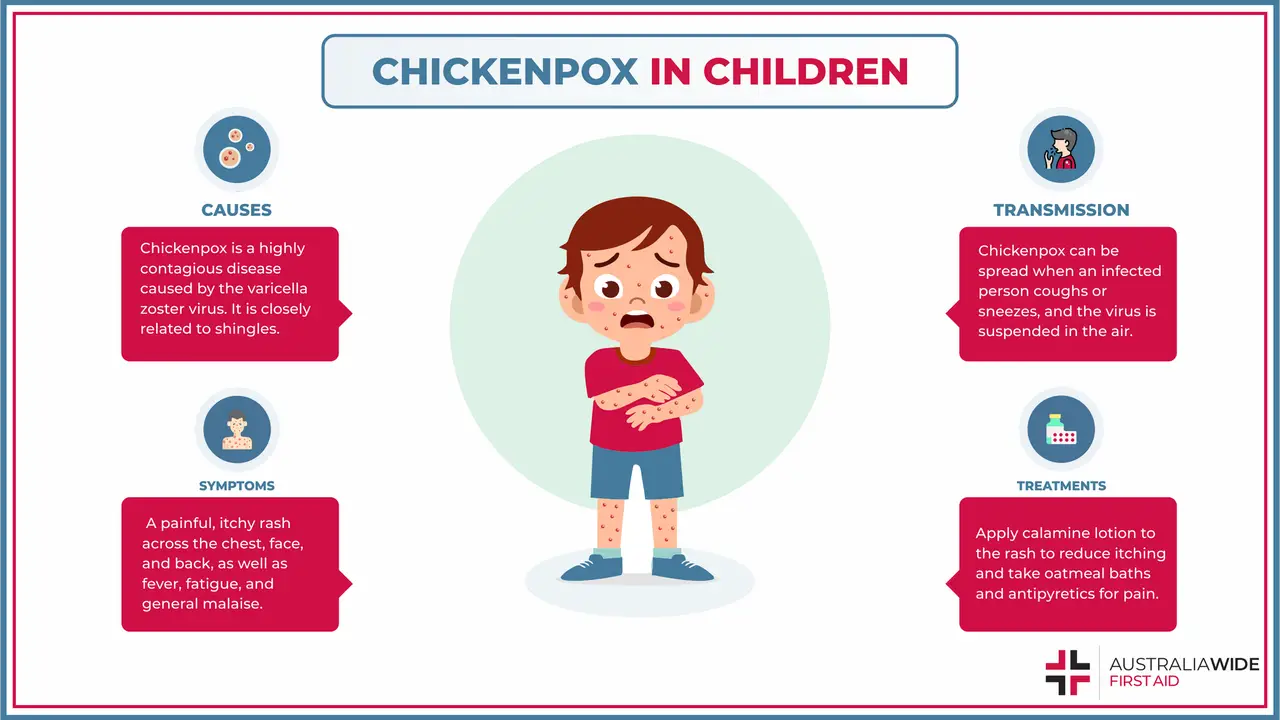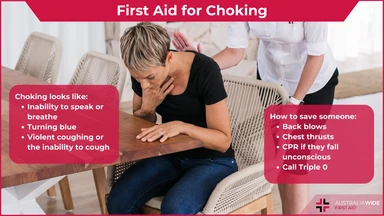Chickenpox in Children First Aid


Chickenpox is a disease caused by the varicella zoster virus. It is best prevented by vaccination and if left untreated can lead to serious illness.
Chickenpox is a highly contagious viral disease that can affect both children and adults. Although it is more prevalent in children, the effects are often more severe in adult populations.
After recovering from chickenpox, the virus remains in your body in an inactive form. Sometimes the virus reactivates later in life and is known as shingles or herpes zoster.
Symptoms of chickenpox are easy to identify and very uncomfortable for the infected person. Fortunately, vaccination is a highly effective method for the prevention of illness and reduction of symptoms.

The most recognisable symptom of an infection with the chickenpox virus is the characteristic red rash. It usually develops first across the chest, face, and back before spreading across the body. The rash is characterised by papules (or raised skin tissue) followed by vesicles (or blisters). While the severity will vary between individuals, there are an average of 500 papules or vesicles per person. Symptoms generally last 1 week.
Symptoms include:
More severe symptoms include:
Infection and symptoms can still occur in vaccinated individuals, but studies show that the severity of symptoms and length of the disease process is shortened significantly after vaccination.
Chickenpox is primarily transmitted in two ways:
It is highly contagious, meaning that it does not take a significant amount of exposure to cause infection. It is most commonly diagnosed in children less than 10 years old and is highly prevalent in daycare and school settings.

Treatment for chickenpox in healthy children is primarily symptom relief. Although there are available antiviral medications on the market, they are typically used for adults with more severe symptoms or immunocompromised individuals. It is important that treatment with antiviral medications begin as soon as possible after the identification of chickenpox. Depending on the severity, antiviral medications can be administered orally or intravenously.
Common treatments for symptoms include:
Historically, an infection with chickenpox virus was associated with a high degree of mortality, particularly in the very young and the very old. The introduction of antiviral medications in the treatment of immunosuppressed and the very ill has significantly reduced the number of deaths from chickenpox virus. Routine administration of antiviral medications in healthy children is not generally recommended.
Another medical model of prevention of chickenpox is vaccination. The introduction and widespread use of the chickenpox vaccine has reduced the incidence and severity of illness. While the vaccine can be administered in one and two-dose series during childhood, it can also be administered within 3 days of exposure to the virus. Even then, it reduces the rate of infection and severity of illness. Therefore, vaccine administration is helpful as a preventative and reactive measure against chickenpox.
For more information on first aid and infection control measures, visit the Australia Wide First Aid article library. You may also be interested in our CPR and First Aid courses

October 13, 2023
Choking occurs when an object or a piece of food becomes lodged in the throat, blocking the airway. The adult or child will have difficulty breathing, and may lose consciousness. Quick and effective action is essential to prevent severe consequences and death.

September 22, 2023
Knowing how to provide first aid for fluid draining from an ear is crucial to alleviate discomfort and potentially prevent complications.

July 31, 2023
This article covers treatment/first aid for nose bleeds, and also covers all of the common misconceptions and myths about treating a bleeding nose.